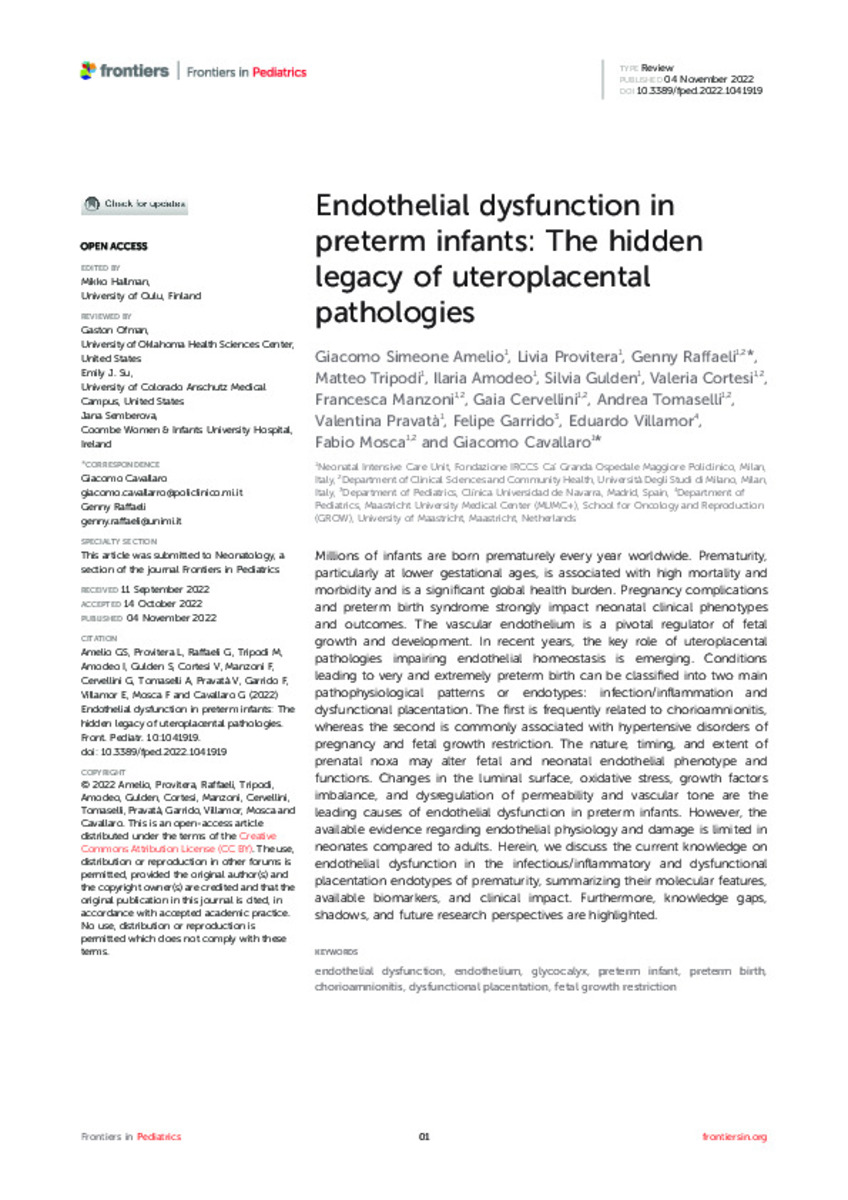Full metadata record
| DC Field | Value | Language |
|---|---|---|
| dc.creator | Amelio, G.S. (Giacomo Simeone) | - |
| dc.creator | Provitera, L. (Livia) | - |
| dc.creator | Raffaeli, G. (Genny) | - |
| dc.creator | Tripodi, M. (Matteo) | - |
| dc.creator | Amodeo, I. (Ilaria) | - |
| dc.creator | Gulden, S. (Silvia) | - |
| dc.creator | Cortesi, V. (Valeria) | - |
| dc.creator | Manzoni, F. (Francesca) | - |
| dc.creator | Cervellini, G. (Gaia) | - |
| dc.creator | Tomaselli, A. (Andrea) | - |
| dc.creator | Pravatà, V. (Valentina) | - |
| dc.creator | Garrido-Martínez-de-Salazar, F. (Felipe) | - |
| dc.creator | Villamor, E. (Eduardo) | - |
| dc.creator | Mosca, F. (Fabio) | - |
| dc.creator | Cavallaro, G. (Giacomo) | - |
| dc.date.accessioned | 2024-01-10T10:24:26Z | - |
| dc.date.available | 2024-01-10T10:24:26Z | - |
| dc.date.issued | 2022-11-04 | - |
| dc.identifier.citation | AMELIO, Giacomo Simeone, et al. Endothelial dysfunction in preterm infants: The hidden legacy of uteroplacental pathologies. Frontiers in pediatrics, 2022, vol. 10, p. 1041919. | es_ES |
| dc.identifier.issn | 2296-2360 | - |
| dc.identifier.uri | https://hdl.handle.net/10171/68242 | - |
| dc.description.abstract | Millions of infants are born prematurely every year worldwide. Prematurity, particularly at lower gestational ages, is associated with high mortality and morbidity and is a significant global health burden. Pregnancy complications and preterm birth syndrome strongly impact neonatal clinical phenotypes and outcomes. The vascular endothelium is a pivotal regulator of fetal growth and development. In recent years, the key role of uteroplacental pathologies impairing endothelial homeostasis is emerging. Conditions leading to very and extremely preterm birth can be classified into two main pathophysiological patterns or endotypes: infection/inflammation and dysfunctional placentation. The first is frequently related to chorioamnionitis, whereas the second is commonly associated with hypertensive disorders of pregnancy and fetal growth restriction. The nature, timing, and extent of prenatal noxa may alter fetal and neonatal endothelial phenotype and functions. Changes in the luminal surface, oxidative stress, growth factors imbalance, and dysregulation of permeability and vascular tone are the leading causes of endothelial dysfunction in preterm infants. However, the available evidence regarding endothelial physiology and damage is limited in neonates compared to adults. Herein, we discuss the current knowledge on endothelial dysfunction in the infectious/inflammatory and dysfunctional placentation endotypes of prematurity, summarizing their molecular features, available biomarkers, and clinical impact. Furthermore, knowledge gaps, shadows, and future research perspectives are highlighted. | es_ES |
| dc.description.sponsorship | This study was (partially) funded by the Italian Ministry of Health – Current Research IRCCS. | es_ES |
| dc.language.iso | eng | es_ES |
| dc.publisher | Frontiers | es_ES |
| dc.rights | info:eu-repo/semantics/openAccess | es_ES |
| dc.subject | Chorioamnionitis | es_ES |
| dc.subject | Dysfunctional placentation | es_ES |
| dc.subject | Endothelial dysfunction | es_ES |
| dc.subject | Endothelium | es_ES |
| dc.subject | Fetal growth restriction | es_ES |
| dc.subject | Glycocalyx | es_ES |
| dc.subject | Preterm birth | es_ES |
| dc.subject | Preterm infant | es_ES |
| dc.title | Endothelial dysfunction in preterm infants: The hidden legacy of uteroplacental pathologies | es_ES |
| dc.type | info:eu-repo/semantics/article | es_ES |
| dc.description.note | This is an open-access article distributed under the terms of the Creative Commons Attribution License (CC BY). | es_ES |
| dc.identifier.doi | 10.3389/fped.2022.1041919 | - |
| dadun.citation.publicationName | Frontiers in Pediatrics | es_ES |
| dadun.citation.startingPage | 1041919 | es_ES |
| dadun.citation.volume | 10 | es_ES |
| dc.identifier.pmid | 36405831 | - |
Files in This Item:
Statistics and impact
Items in Dadun are protected by copyright, with all rights reserved, unless otherwise indicated.






